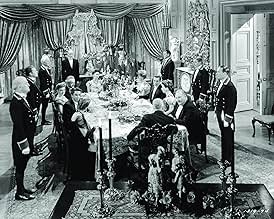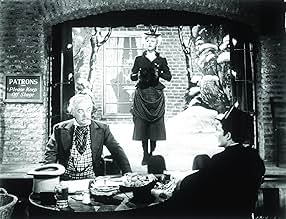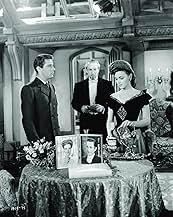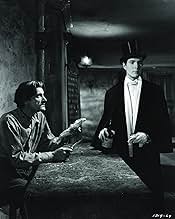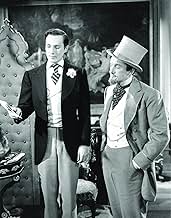AVALIAÇÃO DA IMDb
7,5/10
15 mil
SUA AVALIAÇÃO
Um jovem corrupto de alguma forma retém sua beleza juvenil, mas uma pintura especial revela gradualmente sua fealdade interior a todos.Um jovem corrupto de alguma forma retém sua beleza juvenil, mas uma pintura especial revela gradualmente sua fealdade interior a todos.Um jovem corrupto de alguma forma retém sua beleza juvenil, mas uma pintura especial revela gradualmente sua fealdade interior a todos.
- Ganhou 1 Oscar
- 3 vitórias e 4 indicações no total
Renee Carson
- Young French Woman
- (as Renie Carson)
Lilian Bond
- Kate
- (as Lillian Bond)
Devi Dja
- Lead Dancer
- (as Devi Dja and Her Balinese Dancers)
- Direção
- Roteiristas
- Elenco e equipe completos
- Produção, bilheteria e muito mais no IMDbPro
Avaliações em destaque
This wonderfully atmospheric retelling of Oscar Wilde's chilling novel is one of the best horror films ever made. It outdoes DRACULA and FRANKENSTEIN because it is about a man -- not a monster. Yet the monster IS the man -- and hides within all of us. The story works even more effectively than the similar plot in Robert Louis Stevenson's STRANGE CASE OF DR. JEKYLL AND MR HYDE because here we have the dual sides of a man portrayed not as two separate characters but as two reflecting images -- like two mirrors facing each other, sending the images out to infinity. The painting itself is one of the most horrifing images ever created in films -- a surreal reflection of what each of us can become if we lose our humanity and replace it with careless egotism.
It's hard to say what it is about "The Picture of Dorian Gray" that I enjoyed so much, but I did like it. Hurd Hatfield at first seems miscast and ineffective as the titular character, but somewhere around the one hour mark, his one and only expression begins to grow on you until you feel just as unnerved by his presence as those who come in contact with him in the story. George Sanders--from what I've seen--played one character his enter career but played it so well, and his performance in this film is no exception. Angela Lansbury is surprisingly sympathetic as the sad and timid singer. The only one in the cast who really doesn't work is Donna Reed. Her character feels tacked on, and she isn't allowed to do much but look faithful and beautiful.
The film is shot wonderfully, and Harry Stradling's cinematography gives the East End scenes a dark, atmospheric counter balance to the rather plain and flat interiors of Dorian's home. The swinging lamp was a nice touch and reminded me of "Psycho"'s finale.
I suppose my only criticism is toward the end, the story introduced one or two characters without giving them proper context or background (I'm thinking of the Allen Campbell character). I'm assuming Dorian "convinces" him to take part in his plans because of some sort past homosexual tryst, but it seemed unfair to bring him in they way he was, have him serve the role he does, and then disappear so quickly without explanation. And speaking of suggested themes: Is it just me, or could you make an argument that Dorian is Jack the Ripper? Maybe it's actually pretty obvious or maybe I'm just interpreting too much into the story, but that's what I got out of it.
P.S. I had the opportunity to see the actual painting from the film during an Ivan Albright exhibit at the Metropolitan Museum of Art in 1997. It's even more gruesome in person.
The film is shot wonderfully, and Harry Stradling's cinematography gives the East End scenes a dark, atmospheric counter balance to the rather plain and flat interiors of Dorian's home. The swinging lamp was a nice touch and reminded me of "Psycho"'s finale.
I suppose my only criticism is toward the end, the story introduced one or two characters without giving them proper context or background (I'm thinking of the Allen Campbell character). I'm assuming Dorian "convinces" him to take part in his plans because of some sort past homosexual tryst, but it seemed unfair to bring him in they way he was, have him serve the role he does, and then disappear so quickly without explanation. And speaking of suggested themes: Is it just me, or could you make an argument that Dorian is Jack the Ripper? Maybe it's actually pretty obvious or maybe I'm just interpreting too much into the story, but that's what I got out of it.
P.S. I had the opportunity to see the actual painting from the film during an Ivan Albright exhibit at the Metropolitan Museum of Art in 1997. It's even more gruesome in person.
Hurd Hatfield sells his soul so that his portrait ages and reflects his evil while he stays young in "The Picture of Dorian Gray," based on the classic novel by Oscar Wilde. The film also stars George Sanders, Angela Lansbury, Donna Reed, and Peter Lawford. After wishing to stay young forever and falling prey to the words of a cynical friend, Gray goes against what might have been a decent nature and embarks on a vicious life that brings cruelty, sadness, and even death to those with whom he interacts.
The film is striking for several reasons: There is very little of what one would call action; many scenes are quite short; the film relies heavily on narration; the leading man's face remains impassive throughout. This could have been a recipe for disaster, but instead, "The Picture of Dorian Gray" is an extremely compelling film. This sumptuous production is meticulously photographed, with wonderful use of shadows which help create a dark atmosphere. The performances are excellent, particularly those of a very young Angela Lansbury and George Sanders. Peter Lawford and Donna Reed are the beautiful young things who don't have to depend on a portrait for youth.
Hurd Hatfield surely had one of the strangest faces in film - he certainly looked the part of a young, almost pretty Englishman, with his unlined face, high cheekbones, and full lips. As the role dictates, he was appropriately detached and lacking emotion. Six or seven years earlier, this role would have been perfect for Tyrone Power, who would have imbued it with more charm - making the evil inside Dorian all the more difficult to accept among his friends, and thus, his true personality would have seemed more treacherous. Given the way Hatfield played it, I had no problem believing he was capable of anything, and wondered why his friends didn't buy the nasty rumors.
As for the portrait - what a concept. Would that we all had one in our closets. It would put plastic surgeons out of business.
The film is striking for several reasons: There is very little of what one would call action; many scenes are quite short; the film relies heavily on narration; the leading man's face remains impassive throughout. This could have been a recipe for disaster, but instead, "The Picture of Dorian Gray" is an extremely compelling film. This sumptuous production is meticulously photographed, with wonderful use of shadows which help create a dark atmosphere. The performances are excellent, particularly those of a very young Angela Lansbury and George Sanders. Peter Lawford and Donna Reed are the beautiful young things who don't have to depend on a portrait for youth.
Hurd Hatfield surely had one of the strangest faces in film - he certainly looked the part of a young, almost pretty Englishman, with his unlined face, high cheekbones, and full lips. As the role dictates, he was appropriately detached and lacking emotion. Six or seven years earlier, this role would have been perfect for Tyrone Power, who would have imbued it with more charm - making the evil inside Dorian all the more difficult to accept among his friends, and thus, his true personality would have seemed more treacherous. Given the way Hatfield played it, I had no problem believing he was capable of anything, and wondered why his friends didn't buy the nasty rumors.
As for the portrait - what a concept. Would that we all had one in our closets. It would put plastic surgeons out of business.
One of my personal favorites of films of the '40s is this visually striking version raising the art of black-and-white photography to new heights. The sets and costumes and deep-focus photography combine to make even more absorbing the story Oscar Wilde tells of the man whose portrait decays as he himself remains forever youthful. Hurd Hatfield never had a better role and he makes the most of it. George Sanders, Angela Lansbury, Donna Reed, Peter Lawford, Lionel Gilmore, George Sanders, Morton Lowry and many others contribute to the overall excellence of the acting. The period atmosphere of late-Victorian London adds much to the slowly growing horror of the tale. Complaints by others on this message board that the film is too slow or too talky are foolish. If you want action and special effects, see a Clint Eastwood or Bruce Willis film--forget this. But as a compelling and psychological study of a man influenced by evil (personified by George Sanders as Lord Henry), this version is better than any of the others made since. It's chilling, the way Wilde intended, and no one could deliver his cynical yet witty observations about human nature better than George Sanders. By all means, an outstanding film. Should be required viewing as a study of the art of black-and-white cinematography.
This film adaptation of Wilde's story is certainly one of the great atmospheric black and white films of the 40's. Reminiscent of Greg Toland's ground breaking deep focus cinematography in "Citizen Kane",the shades of black, greys and whites are sharp and clearly deliniated to produce an unforgettable, somewhat eerie look to the film. There are a couple of short Technicolor shots that will make you jump. Cinematography is the star here but let's talk about Hurd Hatfield. I have seen this film on numerous occasions and have yet to figure out whether Hatfield is a great actor or just a woodenly inanimate object. Whichever is the case, this is the role of a lifetime.....it calls for an unfeeling, blank-faced characterization which is exactly as Hatfield played it. His smooth unlined visage hides many things and his apparent lack of emoting is right on target. Does that mean that he just couldn't act and fell into a role that suited his style or does it mean that he rose to the task and his interpretation was the sign of a great actor, living the part. I don't know....all I do know is that he pulls it off with great panache! He was playing against one of the great scene stealers of all times, George Sanders, who spouts Wilde epigrams with his own inimitable class and Hatfield holds his own. The other players are adequate but I don't know what all the excitement is about Angela Lansbury's acting....she was much better in "Gaslight". All in all, this is a movie that I would recommend but beware....it moves slowly, very slowly. Once you see it maybe you can answer the question about Hurd Hatfield's acting.....or maybe not!!!
Você sabia?
- CuriosidadesIn the novel, Sibyl Vane called Dorian Gray "Prince Charming", not "Sir Tristan".
- Erros de gravaçãoAt approximately 34:35 into the film, the time on the clock in the room suddenly changes from just after 2 o'clock to 3 o'clock. Then at approximately 37:00 it moves back to 2:05 and then to 2:09 as Dorian continues to play the piano.
- Citações
Lord Henry Wotton: "If I could get back my youth, I'd do anything in the world except get up early, take exercise or be respectable."
- Versões alternativasSome prints are slightly edited, omitting Dorian's prayer and Lord Henry's line, "Heaven forgive me" in the final scene.
- ConexõesFeatured in The Cinematographer (1951)
- Trilhas sonorasGood-Bye, Little Yellow Bird
(uncredited)
Lyrics and Music by C.W. Murphy and William Hargreaves
Performed by Angela Lansbury
Principais escolhas
Faça login para avaliar e ver a lista de recomendações personalizadas
Detalhes
- Data de lançamento
- País de origem
- Central de atendimento oficial
- Idioma
- Também conhecido como
- El retrato de Dorian Gray
- Locações de filme
- Empresa de produção
- Consulte mais créditos da empresa na IMDbPro
Bilheteria
- Orçamento
- US$ 3.500.000 (estimativa)
- Tempo de duração1 hora 50 minutos
- Cor
- Proporção
- 1.37 : 1
Contribua para esta página
Sugerir uma alteração ou adicionar conteúdo ausente

Principal brecha
By what name was O Retrato de Dorian Gray (1945) officially released in India in English?
Responda

